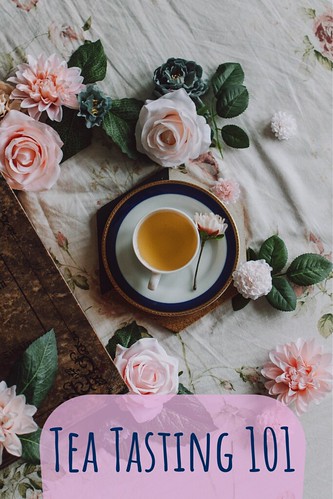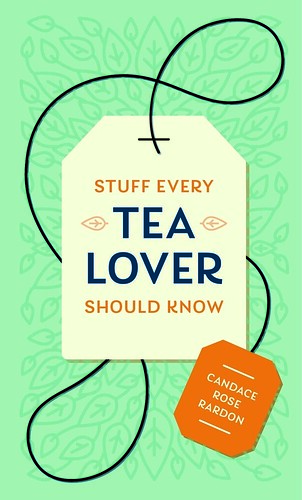We are so excited to share a tasty new book from Quirk Books, entitled Stuff Every Tea Lover Should Know. Here's an excerpt: Tea Tasting 101. Look for an interview with author (and one of our favorite writers and artists), Candace Rose Rardon, soon.

Don’t know how to start appreciating tea on a deeper level? Approaching it like a wine tasting is a fun way of thinking about the breadth and depth of this beverage. There are many parallels between the two worlds.

• Variety: Just as one grape, Vitis vinifera, is the source of countless wine varietals, so do all of the world’s tea cultivars descend from the single Camellia sinensis species.
• Terroir: Wine and tea are both profoundly influenced by the environment they were produced in.
• Tannin: This polyphenol lends its signature astringency to tea and wine alike, especially black teas and red wines.
• Sommeliers: Just as in the world of wine, individuals can train and become certified as professional tea sommeliers.
• Vintage: Fine wines and dark teas are identified by the year and place in which they were produced.
But perhaps the greatest point of connection between wine and tea is the attention required to fully appreciate them. There is so much more to observe than taste alone, from the layered notes of an aroma to the color of a particular brew—and discerning and expressing these qualities take time.
One of the goals of tea tasting is simply to put into words what you’re experiencing: Is the aroma fruity or floral? Is the finish dry or round? What sets this tea apart from others? Here are ten things to evaluate when tasting a quality whole-leaf tea, organized into three stages of the tasting process—before, during, and after you’ve tasted a tea.

BEFORE
• Name of the tea: Before you put the kettle on, take a moment to note important details about the tea you’ll be drinking—what family it belongs to, its country of production, and, for some varieties (such as Darjeeling), even the estate where the leaves were grown. Knowing these facts will also help you prepare the tea with the correct water temperature and infusion time (see chart on page 61).
• Appearance of the dry leaf: Spend time with the dry leaves before brewing, considering their color, shape, the number of buds, etc. Given the kind of tea it is, does it look like it should? For example, if you’re preparing a Silver Needle white tea, do the buds have their defining downy hairs? Or if it’s an oolong tea, are the leaves closer in color to green or black? The dry leaf has a lot to tell you about how the tea was processed and oxidized.
• Aroma of the dry leaf: A huge part of a tea’s flavor in fact has to do with its aromas, starting with the scent of the dry leaves. For an even richer sensory experience, pick up a few of the leaves, bring them close to your ear, and roll them between your fingers—if you hear a crunching sound, this means the leaves are fresh.
Tip: Show off those leaves. When you’re hosting a tea tasting with friends, don’t forget to set out some of the dry leaves for their aroma and appearance to be appreciated. You could place the leaves on a small plate or bowl, or use a cha he—a Chinese tea presentation vessel.

DURING
• Aroma and appearance of the wet leaf: As the leaves absorb the hot water and are rehydrated, their aroma notes change considerably. Study the leaves just after they’ve been infused, comparing the aromas of the dry and wet leaves. Vegetal notes detected at this stage indicate a fresh tea. The infused leaves can sometimes tell you more about the tea than the taste of the liquor itself.
• Aroma of the liquor: A 1977 study found that 80 percent of the flavors we perceive as taste come from what we smell, so it’s no surprise we should smell the infused tea before we taste it. For this step, it’s helpful to use an aroma cup, which resembles a tall, oversized thimble. To use, pour the tea first into the aroma cup, then immediately into your tasting cup—the empty aroma cup allows you to focus solely on how the liquor smells.
• Color of the liquor: Next, take a moment to study the color of the liquor, such as the pale tones of green tea or the rich, coppery reds of black tea. Is the liquor shining and clear? Even the darkest teas should have a sparkling translucence, rather than looking cloudy or murky.
• Taste of the liquor: At last, it’s time to taste the tea! But our sense of smell still plays a big role here, thanks to something known as retronasal olfaction—which basically means we can smell food or drink from inside our mouth. To see this at work, try pinching your nose when you take a sip; much of the tea’s flavor will be suddenly blocked. Now, try exhaling through your nose while you have tea in your mouth and you’ll get an even fuller sense of its aromatic palate.
• Texture of the liquor: This step puts our sense of touch to good use. As we study how the liquor physically feels as we drink, we’re evaluating its texture and mouthfeel: Is the tea rough or smooth? Silky or astringent? Creamy or robust?
Tip: Get personal. Sure, you can look up how a certain tea smells or tastes, but it’s way more fun to experience these qualities for yourself. Record your own first impressions before reading someone else’s opinion, and don’t worry about finding the perfect descriptors right away, either—start by just thinking about what the tea reminds you of and if it conjures any memories. As Don Mei of the British tea company Mei Leaf shares in his YouTube video “How to Taste Tea (Like a Pro)”: “You start to build up a personal connection with the tea… You want not to describe what the tea is, but what the tea is for you.”
AFTER
• Finish of the liquor: How long did the flavor linger in your mouth? Did it dissipate quickly? Or was the taste persistent? Also analyze where you can still feel the tea in your mouth—on the sides of your tongue, the back of your throat, or does it have an all-around full finish? The Chinese have a special term for this quality of tea: hui gan, which loosely translates as “returning sweetness.”
• Tasting notes: Be sure to take notes during each tasting, to gradually develop your vocabulary of aromas, tastes, and textures. You could even get a tea tasting journal (Moleskine makes one), many of which come with flavor wheels for visually mapping a tea’s aromatic profile. With each new variety you try, your journey through the world of tea continues!
Excerpted from Stuff Every Tea Lover Should Know by Candace Rose Rardon. Reprinted with permission from Quirk Books.
